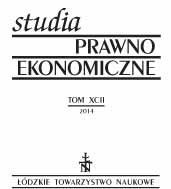STOSUNEK PRACY PRACOWNIKÓW ZAJMUJĄCYCH STANOWISKA KIEROWNICZE – UJĘCIE DEFINICYJNE
THE EMPLOYMENT RELATIONSHIP OF EMPLOYEES HOLDING MANAGERIAL POSITIONS – DEFINITIONAL APPROACH
Author(s): Tomasz DurajSubject(s): Law, Constitution, Jurisprudence
Published by: Łódzkie Towarzystwo Naukowe
Keywords: the employment relationship; employees holding managerial positions; managers; the status of employee of top managers; subordination of the employee to the employer
Summary/Abstract: The object of this study is to analyze the employment relationship of employees holding managerial positions at different levels of management from the perspective of the most important structural features characterizing this relationship. According to the established position of the science of labor law and the settled case law, these characteristic features include: voluntariness and reciprocal obligations, remuneration for the work, work continuity and personal nature of the work performed, the obligation of due diligence, the risk owned by the employing entity and, and subordination of the employee to the employer in the course of their work. Analysis of the characteristic features of the employment relationship of managers indicates that the higher in the hierarchy of the organization the managerial position is, and the larger the area of matters falling within the competence of the executive management employee is, the more atypical the employment relationship is, and the more it departs from the classical model. This tendency is best seen in relation to senior management employees, who, being at the top of the organizational structure, do not have their own superior, and the final economic result of the organization and the level of its competitiveness in legal transactions depend mostly on their attitudes and creativity. In the case of this category of workers, the employee subordination is the least explicit – if there is one at all – and also there are visible far-reaching distinguishing features in terms of employment characteristics such as: personal performance of work, the nature of the obligation, tending towards outcome commitment and risk (especially economic and personal), which burdens the workers to a much greater extent than in the typical employment relationship. This observation de lege lata calls into question the status of employee of top managers. However, the lower in the hierarchy of management the given position is situated, and the lower the area of matters falling within the competence of the executive employee, the more the employment relationship is visible, referring to the classic characteristics of the employment relationship model.
Journal: Studia Prawno-Ekonomiczne
- Issue Year: 2014
- Issue No: 92
- Page Range: 25-49
- Page Count: 25
- Language: Polish

